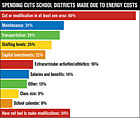
A “School Energy and Environment Survey” was conducted by Honeywell and Education Week Research. Two-thirds of school districts responding to it said they have made spending cuts or modifications as a direct result of rising energy bills. Seventy-four percent of the respondents also said their districts don’t have the money to pursue energy retrofits or renewable energy projects.
“Many districts find themselves caught in a vicious cycle: deferred maintenance and upgrades mean less efficient equipment, which results in higher energy bills and ultimately leading to tighter budgets,” said Paul Orzeske, president of Honeywell Building Solutions.
“Unless districts find solutions to address the required energy and infrastructure improvements,” he said, “they’ll have to dedicate more money to utility bills, and less to teachers, supplies, and other critical needs.”
Contractors who work in this market need to have a variety of skills to help their customers. “The key to bringing a solution is to have the proper blend of components in the project,” said Ron Blagus, energy market director, Honeywell Building Solutions. “There can be hundreds of things that need doing.”
Most projects of this nature start with facility audits and retrocommissioning to find those things that need correction. The key, said Blagus, is to pinpoint improvements that will improve energy consumption in addition to improving operation; audits and retrocommissioning can point out all operational problems, but they might not all offer energy savings.
UNDERSTANDING THE COMPONENTS
“We’ll send engineers into buildings to find those areas that would have the greatest operational payback,” he said. After that, providing detailed communication helps the administrators, who may not understand the mechanics of their HVAC systems. The communication includes a mechanical, operational, and financial report.Blagus advised putting schools in a position to be able to pay back their project financing within 10 years. He also pointed out that under certain conditions, projects can be initiated outside of the district’s budget schedule. “When you structure the financing for a program like this, in a guaranteed project (what’s provided to schools), as soon as it’s finished and commissioned, the savings start on that first day that the project is finished.” It can be based on providing a work-around for an existing budget.
“The key is to know where to look, and to have the proper balance of energy efficiency and renewable energy,” he said. “That’s no small task.”
The situation for schools that was pointed out in the survey, said Blagus, is that they are hurt either by inflation in the energy markets or the volatility in these markets. “If they are adversely affected by that, they need to free up some cash to pay their bills.” That’s when the cuts are made.
On the mechanical side there are a lot of common solutions, he said, “any one of which may have greater benefits depending on the age of the system.” These can apply to boiler systems, chilled water, and fans (fan coils, etc.). The electrical system also provides significant opportunities, such as changes to lighting and building controls.
The survey gathered input from more than 250 district administrators nationwide regarding energy management and environmental sustainability practices. More than one-half of the respondents said they have scaled back, delayed, or eliminated the possibility of energy efficiency and renewable energy projects due to the economic downturn. While 96 percent of the respondents said they view energy management as important to their district’s long-term success, one-third said that they do not have a strategic plan for managing energy consumption and costs.
Although school districts consider renewable energy as a potential solution, many do not have the resources to determine the most suitable investments for their buildings. This is another area where contractors can provide their expertise.
RENEWABLE ENERGY
According to the survey, 61 percent of school districts have evaluated or implemented renewable energy sources, with solar photovoltaic, wind, and geothermal the most popular choices. However, 40 percent of these respondents said they don’t have a clear understanding of the variables that impact the economic viability of renewable technology.Honeywell’s Renewable Energy Scorecard is a predictive instrument that any building owner can use, Blagus said. “We install six different renewable energy technologies, but only where they may warrant a good return.” Clients need both economic value as well as environmental benefits.
“The renewable energy options that seem to be top of mind are telling,” said Jeremy Eaton, vice president of energy solutions for Honeywell Building Solutions. “Solar, wind, and geothermal are the most visible, well-known technologies. However, when we analyze energy prices, resource availability, financial incentives, and other factors, we see biomass thermal as having the greatest financial drivers for the education industry as a whole. And that technology is barely on people’s radar, according to the survey.”
In addition, while there is growing interest for schools to incorporate sustainability practices into their building operations and curriculum, there is a gap between commitment and activity. (The phrase “all talk, no action” comes to mind.) While 26 percent of districts said they have set goals to reduce their carbon footprints, 7 percent have completed a greenhouse gas inventory, which catalogs emissions and sets a baseline.
“Many schools are trying to improve sustainability, but it’s difficult to make changes without having the tools to identify the main areas of concern or measure success,” Orzeske said. “The key is establishing an accurate baseline, and finding the mix of conservation measures that will deliver not only environmental benefits, but also improve the bottom line.”
For more information, visit www.honeywell.com/buildingsolutions.
Publication date:02/08/2010

Report Abusive Comment